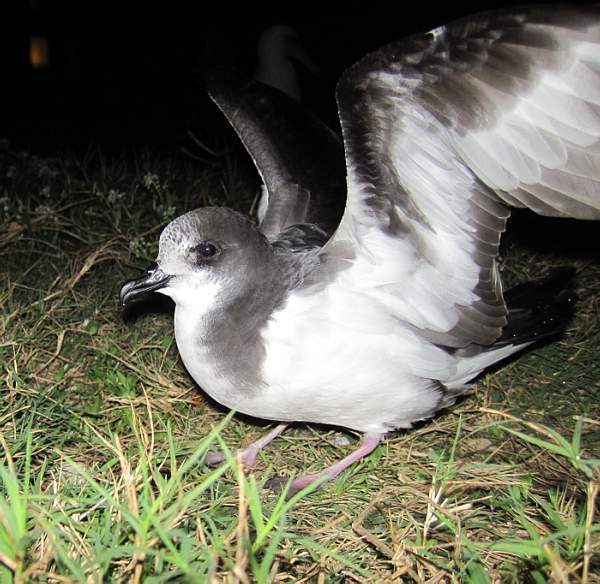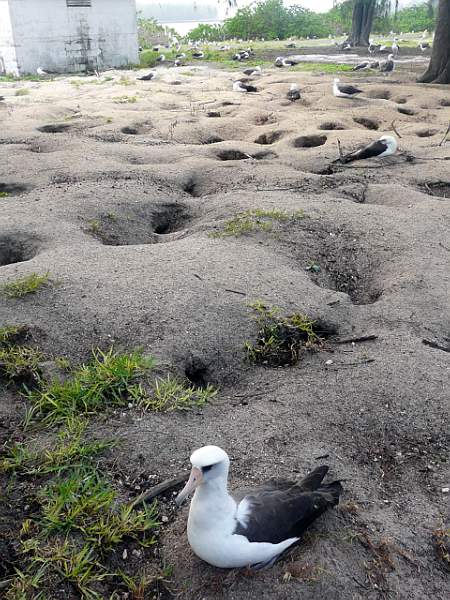Published in the Ocean Watch column, Honolulu Star-Advertiser © Susan Scott
January 4, 2010
Last week in Honolulu when I boarded the airplane to Midway, the pilot announced that strong head winds were going to make the usual five-hour trip a 6 1/2 -hour trip and that it would likely be bumpy. I sighed. I’d only been home from Mexico for three weeks, would spend the next seven days counting albatrosses, and six days after that I’d be traveling with a medical team to Bangladesh.
What was I thinking, I wondered as the hours on the plane crawled by, when I volunteered to work during the holidays on Midway?
Later, as I disembarked on the atoll’s Sand Island, I remembered what I was thinking: Midway is a wildlife wonder of the world.
Midway Atoll lies 1,260 miles northwest of Honolulu in the Papahanaumokuakea National Monument. The atoll has only three islands with a total land mass of 2.3 square miles, yet it’s the breeding grounds to an astonishing 3 million seabirds.
Since the U.S. Fish and Wildlife Service eradicated rats from the islands in 1996, the birds have been thriving, bonin petrels in particular. Without rats eating their eggs, these charming little seabirds made an amazing comeback. From about 60,000 in 1995, the bonins now number more than 900,000.
If you can’t picture a bonin petrel, don’t feel bad. When not breeding, bonins spend their time at sea, west of Hawaii toward Japan.

These seabirds nest in colonies in Japan’s Volcano (Kazan Retto) and Bonin (Ogasawara-gunto) islands. The term “bonin” is an English corruption of the Japanese word “mujin,” meaning “uninhabited.”
Before humans arrived in the main Hawaiian Islands, bonins nested there, too, but they’ve been gone for centuries because of introduced predators. Ancient Polynesians ate bonin petrels, as did the rats and pigs the settlers brought with them.
Bonins continued, however, to nest on most of the islands in Hawaii’s northwest chain.
Here on Midway we live in the midst of hundreds of thousands of these adorable black-and-white birds (that look like they’re smiling), yet it’s hard to get a good look at one. The foot-long seabirds are active at night and nest in deep burrows.
The arrival of bonin petrels at Midway each evening is a marvel of nature. At late dusk, just before the last light of day fades away, the sky comes alive with masses of petrels returning to their nests, a dark cloud reminiscent of bats but with the fluttery appeal of butterflies.
It’s hard to see bonins here but easy to hear them. Their soft chitters, whistles and sighs rise from the ground after dark. Often these sounds occur in poignant duets as couples, which mate for life, court or reunite.
Sometimes on an evening walk, Midway’s residents feel a bonin. Even though the birds have exceptional night vision, moving people confuse them and collisions occur.
Bonins dig their burrows with white webbed feet edged in black, giving the impression they’re wearing bedroom slippers. Many of the burrows are beneath the albatross nests we’re counting, making the island a sort of avian apartment complex.

The bonin petrels of Midway are a true conservation success story. We might not see the little petrels while we’re working during the day, but knowing they’re down there on eggs warms the heart.
I initially turned down the invitation to help count albatrosses this year. I thought I was too busy.
“You have to go!” Craig said, when I told him that. “It’s Midway.”
Of course I had to go. What was I thinking?